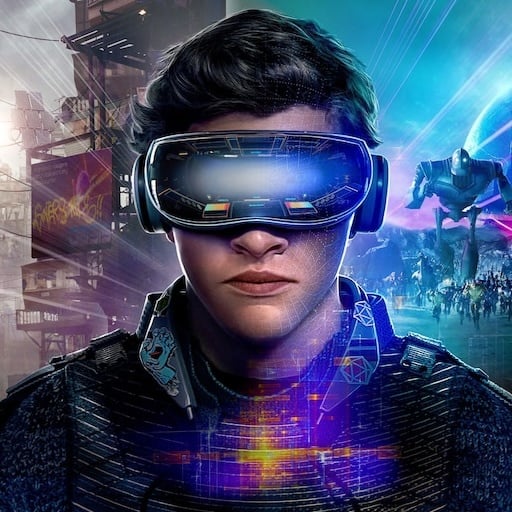VR technology is good at fooling visual and auditory perception, and has made great strides in these areas over the past decade. But when it comes to tactile perception, it’s still largely limited to vibrating controllers, which is a decades old idea. There are VR vests and treadmills, but they are technically quite primitive and not worth the effort for most people.
Ready Player One gives the impression that the OASIS is a parallel world in which you physically participate similarly to the natural world. But the book and the movie don’t explain how this is done technically. Even if we had sophisticated haptic suits and treadmills like in the movie, interacting with virtual worlds would not seem as natural as it does for the protagonists in the OASIS.
Something like this could only be possible with a sophisticated brain-computer interface that somehow enables sensory hallucinations. But this is a dystopian idea more reminiscent of The Matrix than Ready Player One, and infinitely further away in terms of feasibility than archaic technologies like haptic suits and treadmills.
Virtual reality as a gateway to a hyper-realistic parallel world: this is an effective sales concept, but it has little to do with reality. Most people are aware that they are wearing VR headsets when they play games. They are consciously using their real bodies and enjoying it. And they are happy to return to reality after a while. After all, it’s still the best place to cuddle or have a pizza.
I think the term “virtual reality” promises more than it can deliver and may even be based on a misunderstanding. Humanity has developed a wide variety of immersive techniques throughout its history: from the art of storytelling and the cave paintings of Lascaux to film and virtual reality. I believe the latter is just another point in this evolution, not its conclusion.
Just because virtual reality can deceive our visual and auditory senses even more than before, it is not necessarily predestined to become a fully immersive technology. In fact, I believe that in the future, virtual reality will be just one of many, and by no means the most common, application of face computers. And that’s perfectly fine.



Depending on how you mean, it either already exists in VRChat and the like or it’s never going to happen because I.P. licensing will be too fragmented.
I have meet many people that live in VRChat. That part of the book is very much with us today.
Yup.
I’m constantly frustrated with limitations, performance issues and the limited number of people in a shared space.
Also, instances are not the model I think a real metaverse should use. Or at the least, not the main model.
I want contiguous canonical shared space. If an event fills up, that means it really filled up. Just like an IRL space. Hold it in a bigger space next time if you need more space.
Sigh… instances really bum me out. 80 people ain’t enough.
If you want a real-time environment then there are computational limits to how many people can interact with each other in a space.
Every person has 3-5 tracked points between headset, controllers, and optional addon foot trackers. Each tracked point has six degrees of freedom. At every update to the state of the virtual world, each person has 19-31 floating point variables to refresh just for their body position alone. With 80 people in a world, there could be 1,520-2,480 values that need to be updated and sent out to all 80 people. Vrchat worlds have a tic rate of 5-30 frames per second, but even at the lowest rate, doing nothing but single-precision positional updates for 80 players will require the server to upload a constant stream of ~30Mb/s.
We haven’t even considered audio, processing power, or network overhead yet, the bandwidth needed for character positioning alone puts a 3-4 digit upper bound on server population.
There’s no supercomputer that exists which could host a real-time virtual world on the scale of a small town. Instancing is necessary to keep server populations low enough to be practical. Larger MMO game servers only function by hiding people or slowing the tic rate. For example, in Planetside, if you try to get too many players into a small area then you’ll only see the hundred or so nearest ones. In Eve Online, if there are too many ships in a single solar system to process it in real-time then the game responds by running the entire system in slow-motion.
I hope we’ll eventually see a good decentralized algorithm for networked virtual worlds, but existing ones have to impose strict “speed limits” to keep everything in sync. This might not a problem for walking simulators, but nobody’s going to be racing cars with tens of thousands of real-time spectators as in the movie.
Believe me. I know.
I’ve been around VRChat since 2016, know many current and former devs. I’ve discussed this sort of thing over and over during the past 8 years.
I’ve also been in high fidelity where they successfully ran events with hundreds of people.
https://www.highfidelity.com/backlog/new-record-256-avatars-together-7f094b569a9c
I was at this event, and the crowd feel was amazing. But it took a very expensive array of servers to pull it off. VRChat is peer to peer. High Fidelity was server based and used a set of discrete servers to host the different aspects of the platform. Player location/pose, voice mixing, etc. Each aspect had their own server processing and compressing and streaming the data to each user. I forget how many there were total.
I’m not asking for 1000 people. I’m yearning for something around 333 people.
Edit: oh, and I’m also aware of there being private tests where they achieved ~200 people, stable, in a single instance in VRChat. I forget the exact count. I think it’s still under High Fidelity’s record.